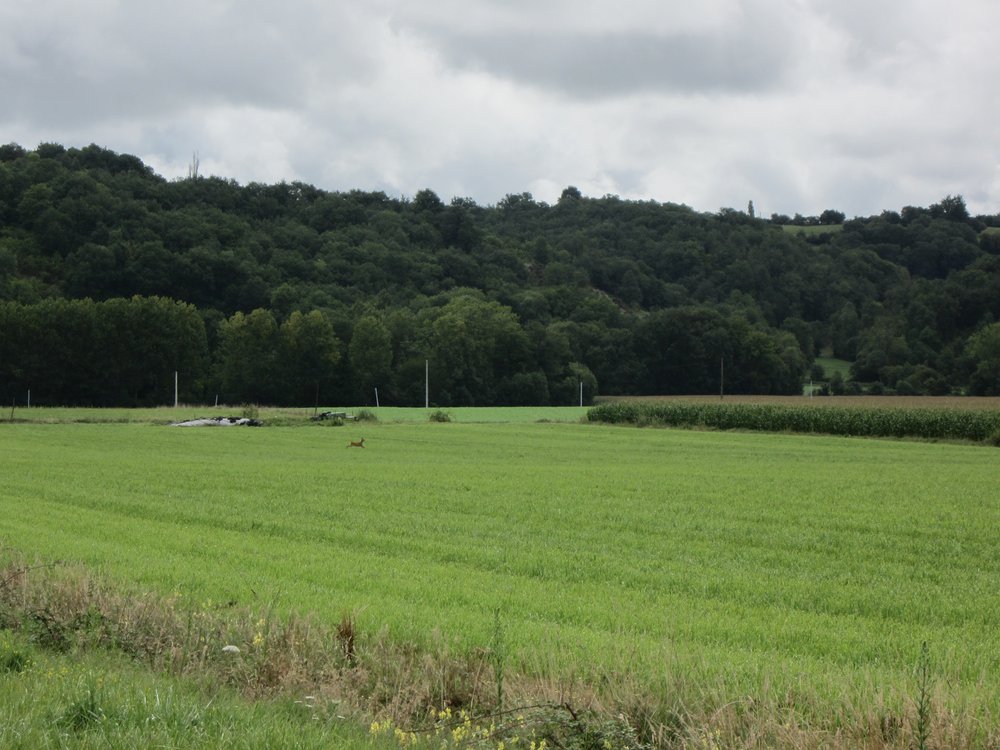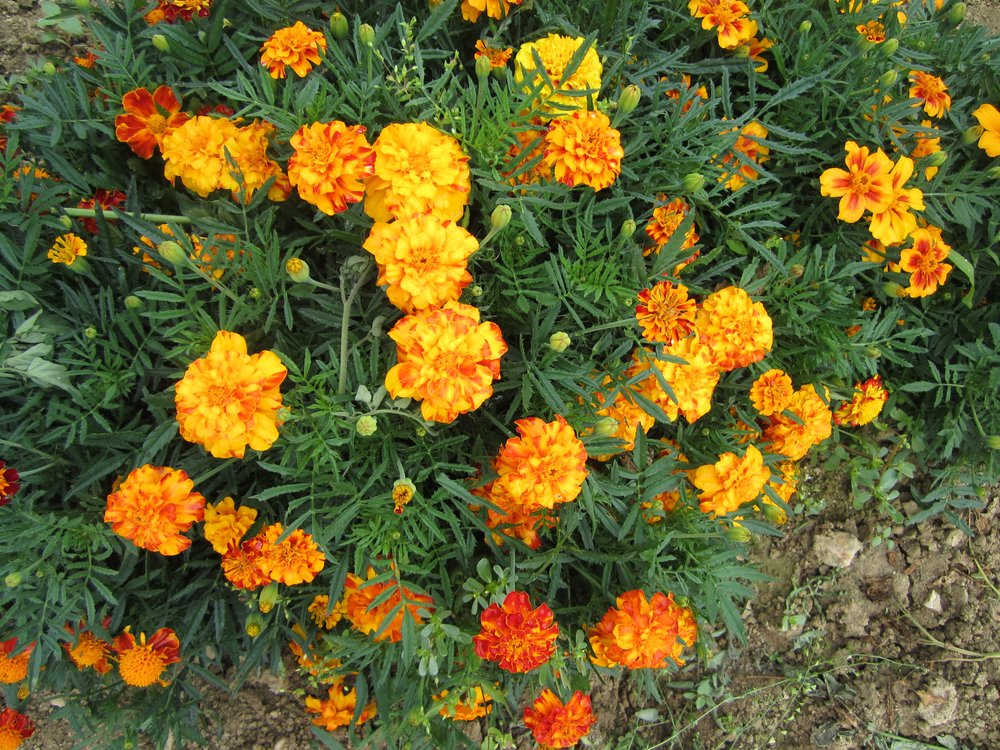 Sunday morning. It rained in the night, so it’s cool in the morning when I head out south on the main road, intending to drop down one of the narrow roads that take farmers to their fields. Corn and sunflower fields give over to empty fields, filled with birds lively in the cooler air: the great tit, swallows decorating the power lines that seem to run everywhere I look, tree sparrows. I flush a pair of woodcocks, who sail off in a flurry of wings. Then I cross a small bridge, and on the other side am in a new department, the Haute Pyrenees. When I was a child, we often walked to the bridge after dinner, hopping from one side to the other, saying, “now I am in the Gers, now in the Haute Pyrenees.” There was no difference, the line entirely political. But we loved it, as we loved those evening walks.
Sunday morning. It rained in the night, so it’s cool in the morning when I head out south on the main road, intending to drop down one of the narrow roads that take farmers to their fields. Corn and sunflower fields give over to empty fields, filled with birds lively in the cooler air: the great tit, swallows decorating the power lines that seem to run everywhere I look, tree sparrows. I flush a pair of woodcocks, who sail off in a flurry of wings. Then I cross a small bridge, and on the other side am in a new department, the Haute Pyrenees. When I was a child, we often walked to the bridge after dinner, hopping from one side to the other, saying, “now I am in the Gers, now in the Haute Pyrenees.” There was no difference, the line entirely political. But we loved it, as we loved those evening walks.
I look down a narrow passageway, between two corn fields, and spy two fox trotting toward me. They don’t see me right away, so I watch them through my binoculars, their long legs taking light, wary steps. And then they turn sharply and vanish into the corn.
 As I near the Boues, the river that carved this valley, the land flattens out. This is an area that Odette refers to as La Plaine. The plains. It is where they grew their hay and wheat. In the summer Becky and I would help Stanis and Odette bring in the small bails of hay and straw. We’d shove in a pitchfork, then in a swoop, lift them above our head to land on the wooden cart pulled by the tractor. Stanis would arrange the bales of straw or hay, as we walked by the slow moving tractor. In the evenings, we’d return home, our hair speckled with straw, straw down our backs and in our bras. And happy.
As I near the Boues, the river that carved this valley, the land flattens out. This is an area that Odette refers to as La Plaine. The plains. It is where they grew their hay and wheat. In the summer Becky and I would help Stanis and Odette bring in the small bails of hay and straw. We’d shove in a pitchfork, then in a swoop, lift them above our head to land on the wooden cart pulled by the tractor. Stanis would arrange the bales of straw or hay, as we walked by the slow moving tractor. In the evenings, we’d return home, our hair speckled with straw, straw down our backs and in our bras. And happy.
I come to a stand of trees. I have been hearing woodpeckers on this trip, but had yet to lay eyes on a bird. There was a time when I wasn’t fond of the woodpecker in Estampes, as they drilled holes in our wooden shutters, slowly destroying them. But now, of course, the woodpecker—a favorite. And there in this small area of dense oak trees, with its bright red flanks is the great spotted woodpecker (wish I had a photo!). Soon after in a field I spy more cattle egret, and one lone grey heron (very much like our blue heron) hunting in a field.
I pass three farmhouses, all beautifully fixed up, new shutters still closed on this Sunday morning. The tractors sit idle; not even the resident dog is there to bark at me as is usually the case. A few collared doves flutter about.
These roads I’m walking are the same roads I taught my niece and nephew to drive on. They were perfect learning roads in that 99% of the time there are no other cars. The downside is that when there was a car, there was little room for two cars to pass. So Alice or Thomas would stop, let me take over the wheel as I inched by the other car. On both sides dramatic ditches threatened to swallow a car.
I spy a hen harrier, grey-white high on a pole, then it swoops off. In a field to my right, a deer, the fifth one I’ve seen on this walk. I have seen deer in the past, but not so many. So the question is: are there more deer, or am I simply seeing them?
My return is quiet until a falcon comes zipping in overhead and slams into a magnolia tree. There’s a rumpus of squawks, then quiet. The falcon got its meal.
And I’m thinking about my lunch as well. So I drive into Mielan, the nearest town to Estampes, where there is a small Sunday market. I tell the melon man from Lectour that I want three melons, one for tonight and two for Monday. He numbers them in black ink so I’ll know which one is ripest.
 I arrive at a small vegetable vendor just as he sells off the last of his lettuce. “Come to my house,” he says, “I have lots more lettuce.” So I get in his car and he takes me to his spread of a garden, overflowing with flowers, melons, tomatoes, and lettuce. He’s retired, so this is a bit of a hobby, but he’s a gardener who likes to experiment. There are some peanut plants he hopes will grow and five corn stalks from seeds he found down by the river. I tell him he should grow sweet corn. He can’t, he tells me. When he was young, he worked inspecting farmer’s milk machines. Often the farmers would invite him for lunch. They would kill a chicken and serve it to him. Sometimes he’d find grains of corn in his chicken (someone should have cleaned their chickens better!). Corn is for chickens, he explained, handing me two large bouquets of flowers: dahlias, marigolds, black eyed Susans, gladiolas. Flowers, whether in the US or in France, are always beautiful.
I arrive at a small vegetable vendor just as he sells off the last of his lettuce. “Come to my house,” he says, “I have lots more lettuce.” So I get in his car and he takes me to his spread of a garden, overflowing with flowers, melons, tomatoes, and lettuce. He’s retired, so this is a bit of a hobby, but he’s a gardener who likes to experiment. There are some peanut plants he hopes will grow and five corn stalks from seeds he found down by the river. I tell him he should grow sweet corn. He can’t, he tells me. When he was young, he worked inspecting farmer’s milk machines. Often the farmers would invite him for lunch. They would kill a chicken and serve it to him. Sometimes he’d find grains of corn in his chicken (someone should have cleaned their chickens better!). Corn is for chickens, he explained, handing me two large bouquets of flowers: dahlias, marigolds, black eyed Susans, gladiolas. Flowers, whether in the US or in France, are always beautiful.


